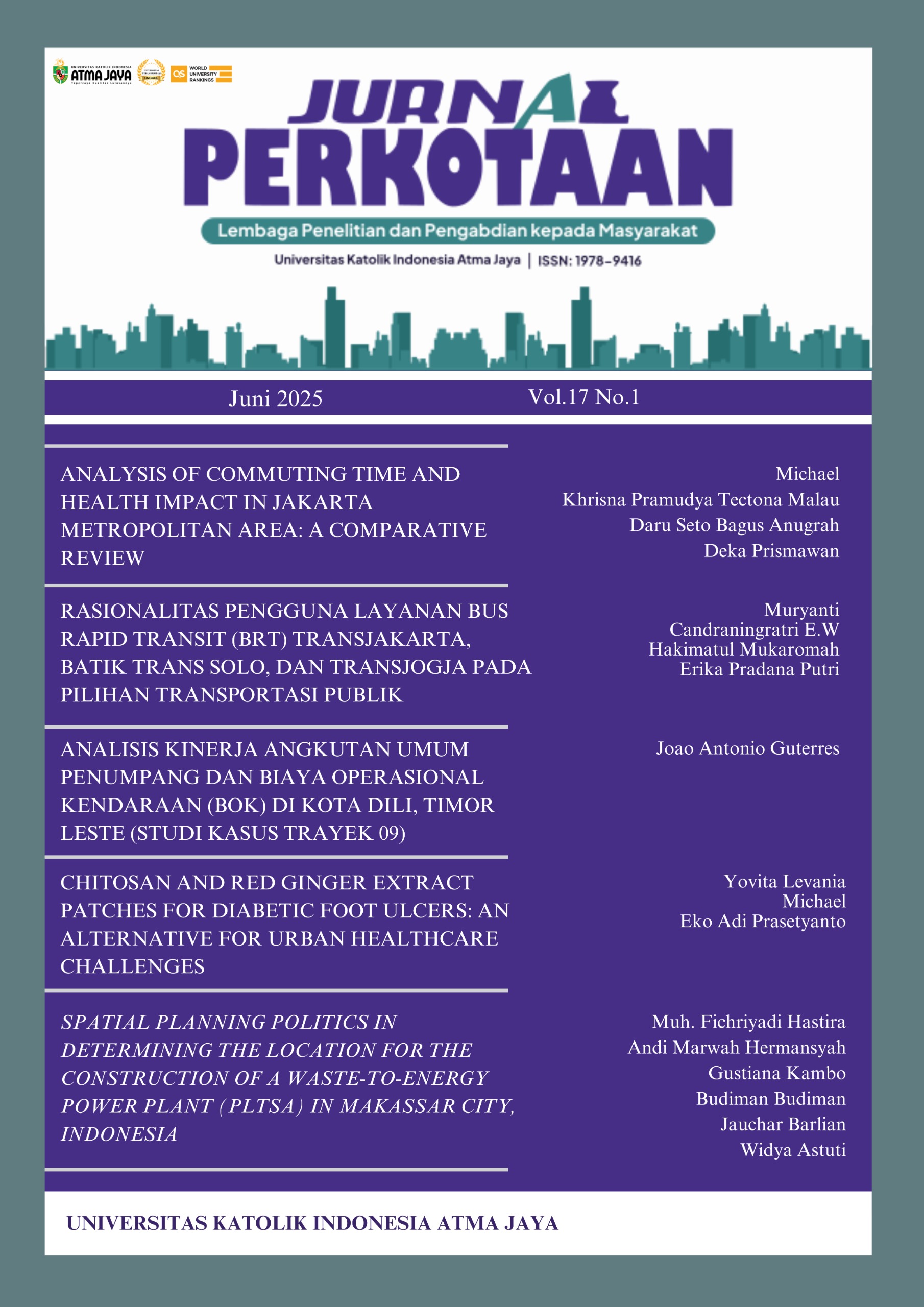Chitosan and Red Ginger Extract Patches for Diabetic Foot Ulcers: An Alternative for Urban Healthcare Challenges
DOI:
https://doi.org/10.25170/perkotaan.v17i1.6187Keywords:
Diabetic foot ulcers, Chitosan, Red ginger, Wound Dressing, AntimicrobialAbstract
Diabetic foot ulcers (DFUs) are a severe complication of diabetes, particularly in urban areas where healthcare access and infection risks pose significant challenges. This study investigates the potential of transdermal patches combining chitosan and red ginger (Zingiber officinale var. rubrum) extract to improve DFU care. Patches were formulated with varying concentrations of chitosan (2%, 3%, and 4%) and red ginger extract (0%, 5%, 10%, and 15%) and evaluated for physical properties, moisture retention, durability, and antimicrobial activity against Staphylococcus aureus. Results identified 3% chitosan with 5% red ginger extract as the optimal formulation, offering superior water retention, balanced durability, and moderate antimicrobial efficacy. These findings highlight the potential of chitosan-red ginger patches as cost-effective, adaptable solutions for DFU care, addressing critical needs for infection control, hydration, and patient comfort in resource-limited urban healthcare settings. Future studies should validate clinical efficacy and investigate scalability for broader implementation.
References
[1] World Health Organization, Global report on diabetes. Geneva: World Health Organization, 2016. Accessed: Dec. 03, 2024. [Online]. Available: https://iris.who.int/handle/10665/204871
[2] Z. Gassasse, D. Smith, S. Finer, and V. Gallo, “Association between urbanisation and type 2 diabetes: an ecological study,” BMJ Global Health, vol. 2, no. 4, p. e000473, Oct. 2017, doi: 10.1136/bmjgh-2017-000473.
[3] K. McDermott, M. Fang, A. J. M. Boulton, E. Selvin, and C. W. Hicks, “Etiology, Epidemiology, and Disparities in the Burden of Diabetic Foot Ulcers,” Diabetes Care, vol. 46, no. 1, pp. 209–221, Jan. 2023, doi: 10.2337/dci22-0043.
[4] C. Mottola et al., “Susceptibility patterns of Staphylococcus aureus biofilms in diabetic foot infections,” BMC Microbiology, vol. 16, no. 1, p. 119, Jun. 2016, doi: 10.1186/s12866-016-0737-0.
[5] D. Makeri, M. Odoki, E. Eilu, and E. Agwu, “Update on prevalence and antimicrobial resistance of Staphylococcus aureus and Pseudomonas aeruginosa isolated from diabetic foot ulcers in Africa: a systematic review and meta-analysis,” Bulletin of the National Research Centre, vol. 47, no. 1, p. 145, Oct. 2023, doi: 10.1186/s42269-023-01119-5.
[6] T.-W. Tan, R. M. Crocker, K. N. B. Palmer, C. Gomez, D. G. Armstrong, and D. G. Marrero, “A qualitative study of barriers to care-seeking for diabetic foot ulceration across multiple levels of the healthcare system,” Journal of Foot and Ankle Research, vol. 15, no. 1, p. 56, Aug. 2022, doi: 10.1186/s13047-022-00561-4.
[7] S. Mahluji, A. Ostadrahimi, M. Mobasseri, V. Ebrahimzade Attari, and L. Payahoo, “Anti-Inflammatory Effects of Zingiber Officinale in Type 2 Diabetic Patients,” Advanced Pharmaceutical Bulletin; eISSN 2251-7308, 2013, doi: 10.5681/APB.2013.044.
[8] M. Firdaus, M. Daniswara, K. Jamaluddin, and N. Andriani, “Reveal the Potency of Water Hyacinth and Red Ginger Extract as Hydrogel Wound Dressing for Mrsa Diabetic Wound: a Short Review,” nat, vol. 30, no. 1, pp. 9–23, Mar. 2021, doi: 10.53656/nat2021-1.01.
[9] E. I. Oprita, A. Iosageanu, and O. Craciunescu, “Natural Polymeric Hydrogels Encapsulating Small Molecules for Diabetic Wound Healing,” Gels, vol. 9, no. 11, p. 867, Oct. 2023, doi: 10.3390/gels9110867.
[10] H. Liu et al., “A smart hydrogel patch with high transparency, adhesiveness and hemostasis for all-round treatment and glucose monitoring of diabetic foot ulcers,” J. Mater. Chem. B, vol. 10, no. 30, pp. 5804–5817, 2022, doi: 10.1039/D2TB01048H.
[11] H. Handayani et al., “Analysis of Antibacterial Effectiveness of Red Ginger Extract (Zingiber Officinale Var Rubrum) Compared to White Ginger Extract (Zingiber Officinale Var. Amarum) In Mouth Cavity Bacterial Streptococcus Mutans (In-Vitro),” 2018. Accessed: Dec. 23, 2024. [Online]. Available: https://www.semanticscholar.org/paper/Analysis-of-Antibacterial-Effectiveness-of-Red-Var-Handayani-Achmad/01e7e45f717536eb1a89de6f9587b065141c1efd?utm_source=consensus
[12] S. Akbari, Z. Didar, M. Vazifedoost, B. Hajirostamloo, and M. Mohtashami, “Antibiofilm Activity of Ginger (Zingiber officinale) Extracts In Vitro and Food Model,” Journal of Food Processing and Preservation, vol. 2023, pp. 1–8, Mar. 2023, doi: 10.1155/2023/5134332.
[13] H. Shimoda et al., “Anti-inflammatory properties of red ginger (Zingiber officinale var. Rubra) extract and suppression of nitric oxide production by its constituents,” J Med Food, vol. 13, no. 1, pp. 156–162, Feb. 2010, doi: 10.1089/jmf.2009.1084.
[14] S. W. Suciyati and I. K. Adnyana, “Red ginger (Zingiber officinale roscoe var rubrum): A review,” Pharmacologyonline, vol. 2, no. 8, pp. 60–65, 2017.
[15] S. Juariah et al., “Antibacterial Activity of Red Ginger (Zingiber officinale var. rubrum) and Black Turmeric (Curcuma caesia) Extracts as Growth Inhibitors of Klebsiella pneumonia,” Tropical Journal of Natural Product Research, vol. 7, no. 8, Aug. 2023.
[16] E. Gianino, C. Miller, and J. Gilmore, “Smart Wound Dressings for Diabetic Chronic Wounds,” Bioengineering, vol. 5, no. 3, p. 51, Jun. 2018, doi: 10.3390/bioengineering5030051.
[17] S. O’Callaghan, P. Galvin, C. O’Mahony, Z. Moore, and R. Derwin, “‘Smart’ wound dressings for advanced wound care: a review,” J Wound Care, vol. 29, no. 7, pp. 394–406, Jul. 2020, doi: 10.12968/jowc.2020.29.7.394.










